Rhino (Rhinoceros)
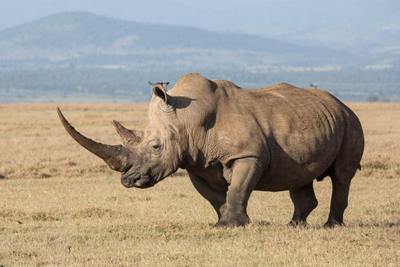
Content:
Rhinoceros – is the famous animal of Africa; a kind of symbol of the “black continent”. Not without a reason, rhino enters into the “big African five” along with an elephant, a buffalo, a lion and a leopard, the same five animals that were once the most honorable hunting trophies. The rhino has weak eyesight, but with its size and strength, it is not its problem.
Description and Characteristics.
What does a rhino look like? The rhino scientific name – Rhinocerotidae means “nose”, and “ceros” – horn. This name aptly characterizes this beast, because the big horn on the nose, growing from the nasal bone is an important attribute of all rhinos.
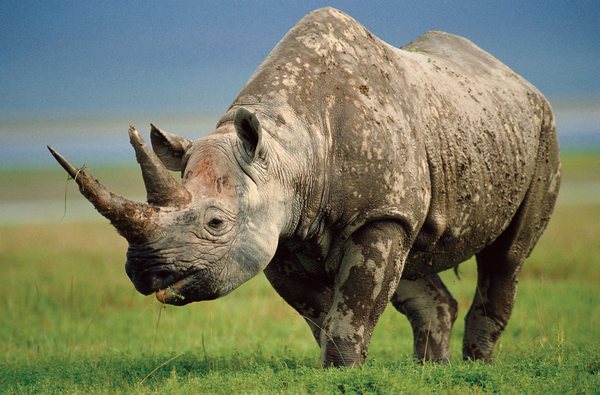
Some people ask: “how big is a rhino?” and “is a rhino a mammal?”. The rhino is the biggest land mammal after an elephant – the length of a rhino varies from 2 to 5 meters, with a height of 1-3 meters. How much does a rhino weigh? The average weight of a rhino is 2-3.6 tons.
The colors of rhinos depend on their species. It seems that the names of rhino species originated from their color: the white rhino, the black rhino. In fact, the real color of the skin of all rhinos is the same – gray-brown. Yet due to the fact that rhinos love to wallow in the ground of different colors, they got their names.
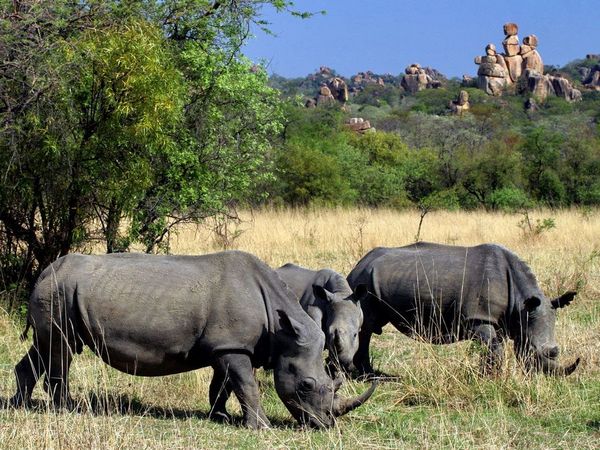
The head of the rhino is long and narrow, with a steep forehead. A small rhino’s eyes with brown or black pupils look very contrast to the background of their large head. As we mentioned at the beginning, rhinos have weak eyesight – they can only see moving objects from a distance of no more than 30 meters.
The sense of smell in rhinos is well developed, so they mostly rely on the smell. Interesting fact: the size of the nasal cavity in rhinos is larger than the size of their brain.
A rhino’s hearing is well developed. A rhino’s ears are like tubes that constantly rotate, catching even a weak sound.
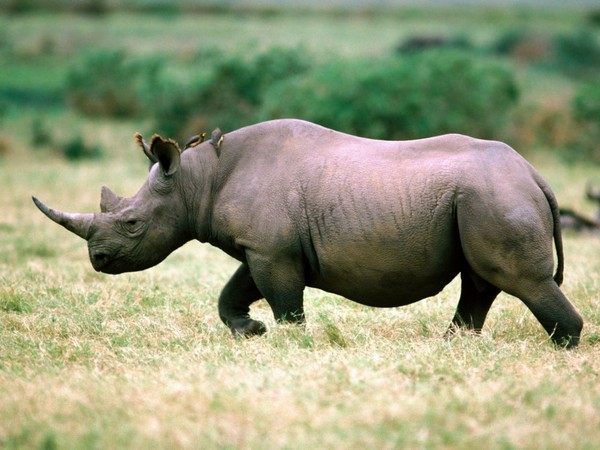
A rhino’s lips are straight and clumsy, with the exception of the Indian and black rhinos, which have a mobile lower lip. All rhinos have 7 cheek teeth in the dental system; they are strongly erased with age. In addition to the teeth, Asian rhinoceros have incisors that are absent in African rhinos.
All rhinos have thick skin, which is almost completely devoid of fur. The Sumatran rhino is an exception; its skin is still covered with brown fur.
The legs of the rhinoceros are heavy and massive. There are three claws on each foot.
Horn
A rhino’s horn is his business card and should be mentioned separately. So, depending on the species, a rhino may have one or two horns, with the second horn located closer to the head. Rhino horns consist of the protein keratin; hair and nails in humans, a needle in porcupines, feathers in birds, and armor in an armadillo has the same protein.
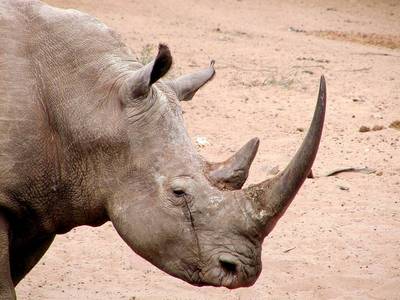
In general, all the functions of the rhinoceros horn have not been fully studied by zoologists, but for instance, scientists have noticed such a curious fact – if the horn is removed from the female rhino, then she will no longer be interested in her baby.
The white rhino is the owner of the longest horn; it reaches 158 cm in length.
Habitat
Where do rhinoceros live? There are five species of rhinos: three of them live in Southeast Asia, these are the Indian rhino, the Sumatran rhino and the Javanese rhino, and two species live in Africa, these are the black rhino and the white rhino.
Lifespan
How long do rhinos live? The life span of rhinos is long: African rhinos live in the wild for an average of 30–40 years and live to 50 years in zoos. Yet the biggest long-livers among rhinos are Indian and Javanese rhinos, which can live up to 70 years, almost as a term of human life.
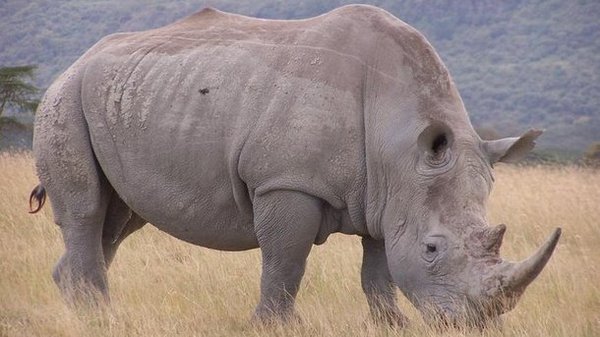
Lifestyle
All rhinos live alone, without creating herds. White rhinos are exceptions; they form small herds consisting of females and baby rhinos. Males and females of rhinoceros gather only during mating. Despite such a peculiar hermit life, rhinos have friends among other members of the animal world – dragging (little birds) constantly accompany rhinos, pecking insects and ticks off their skin.
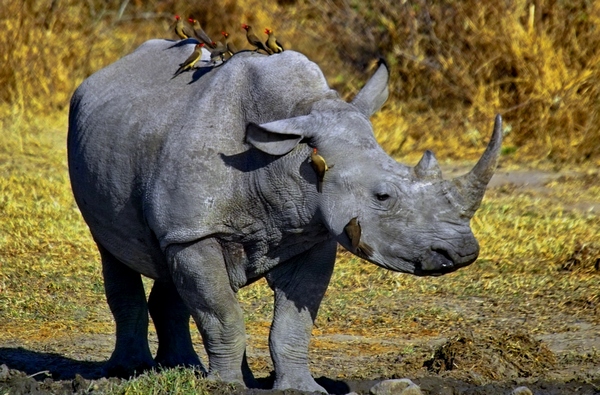
Each rhino has its own territory – a pasture area which is its personal “land”. The rhino jealously guards its territory. The rhinoceros mark the borders of their “possessions” with heaps of dung, which also serve them as a kind of “aromatic” landmark, which allows them to navigate in space and stay within their “lands”.
Rhinos are especially active in the morning and in the evening. At this time they actively eat. During the day and the night, rhinos sleep on their stomachs or taking the “mud baths” so beloved by them. The rhinoceros sleep is very strong, and some people say that at this time you can easily sneak up on them and even grab them by the tail (but still we highly recommend you not to do this))).
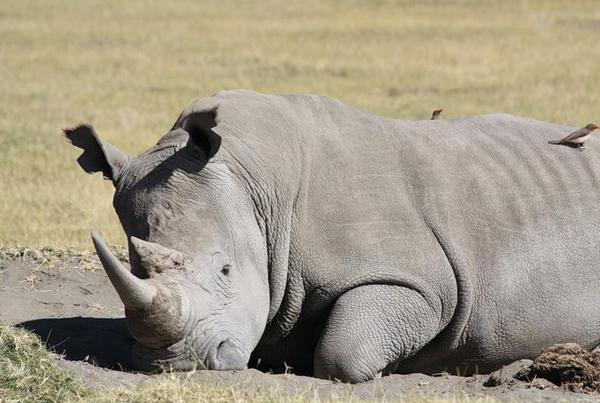
Rhinos are cautious animals. They avoid people, but when they feel danger, they always attack first, and they attack very violently. That is why you need to be extremely careful and delicate when meeting with a rhino. An angry rhino can run at a speed of 40-45 km per hour, and nothing can stop such a running beast, for instance, it can easily ram and even flip a light car.

Diet
What do rhinos eat? Rhinos are herbivores. However, they are very voracious, so on average, a rhino eats up to 72 kg of plant food per day. The main diet of rhinoceros is grass and leaves falling from trees. Black and Indian rhinos may eat the shoots of trees and shrubs. Sugarcane is a favorite delicacy of the Indian rhino, while the Sumatran rhino loves various fruits, especially figs and mangoes.
Why Are Rhinos Endangered?
The main enemy of the rhinoceros is the man who once mercilessly exterminated these animals, mostly for the sake of their famous horns, which, according to popular belief, have many healing properties. They were exterminated to the point that now all five species of rhinos are listed in the Red Book, since due to their low numbers they are on the verge of extinction.
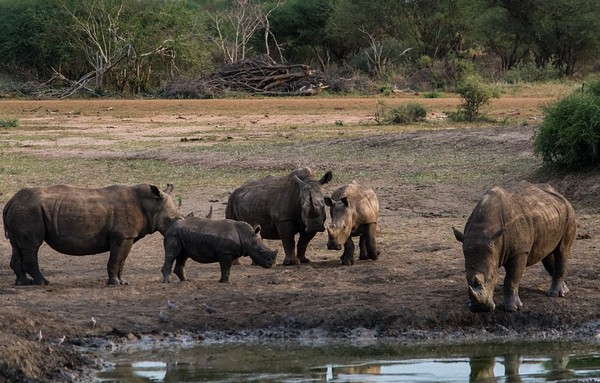
Species
There are five types of rhinos and we’ll describe them all.
White Rhino
The white rhino is the largest rhino species in the world and the least aggressive among rhinos. Its body length is 5 m, height is 2-3 m and weight is 2-3 tons. The white rhino has two horns; the main horn is the largest in the rhinoceros family. The white rhino lives in Eastern and Southern Africa.
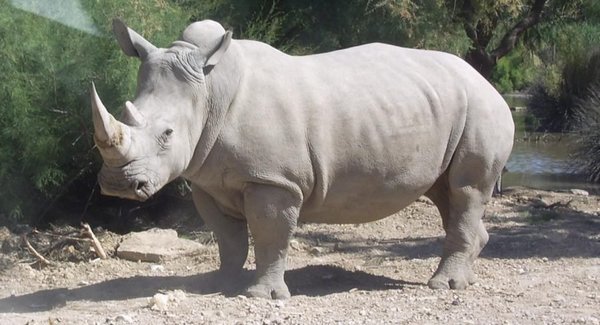
Black Rhino
This species of rhino is extremely dangerous due to its aggressive nature. The black rhino can react quite nervously at the approach of a person (even if it is an innocent tourist with a camera), so you should stay away from it. The black rhino has two horns, one large and the second smaller. The body length of the black rhino is up to 3 m. The black rhino has a mobile black lip. The black rhino lives in Western, Eastern and Southern Africa.
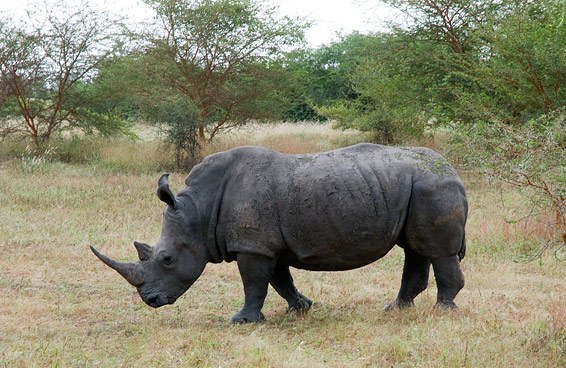
Indian Rhino
As you probably guessed, India is the birthplace of the Indian rhino, but in addition to it, Indian rhinos also live in Nepal. The body length of the Indian rhino is about 2 m and with a body weight of 2.5 tons. The Indian rhino has just one horn, and it, unlike the African rhinoceros, is not sharp, but more blunt and convex.
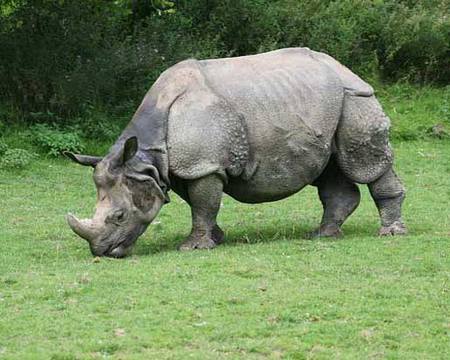
Sumatran Rhino
The Sumatran rhino is the only one among rhinos whose skin is covered with a small fur. Which is why it is sometimes also called the “hairy rhinoceros”. The Sumatran rhino is the oldest among all rhinos. The body length of the Sumatran rhino is 2.3 m and weighs 2.25 tons. The Sumatran rhino is the smallest among rhinos, but despite this, it remains one of the largest representatives of the animal world of our planet. The Sumatran rhino lives on Sumatra Island (in Indonesia) and in Malaysia.
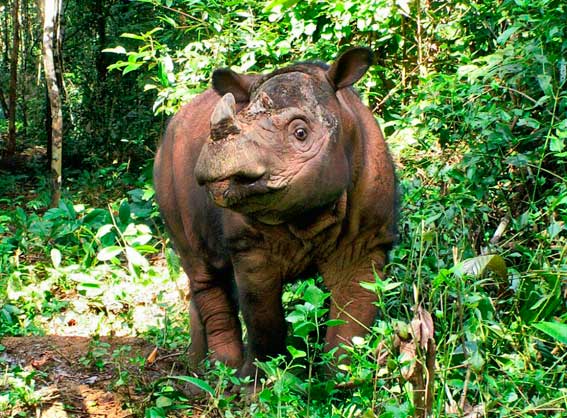
Javan Rhino
This rhino is in a particularly poor condition, according to estimates of zoologists, there are only about 50 individuals of the Javan rhino are currently preserved. It dwells only on the island of Java in a specially created reserve for it, in which all efforts are made for its subsequent preservation. The Javanese rhino is similar to the Indian rhino, but its characteristic distinguishing feature is the complete absence of horns in females. Only males of the Javan rhino have horns.
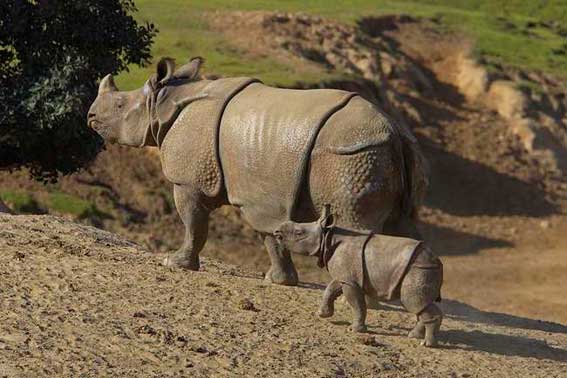
Rhino Breeding
Rhinos reach sexual maturity in the 7th year of life. Yet the male rhinoceros can begin the process of mating with the female only after he has acquired his territory. The mating season usually happens every six weeks, during this period the male begins an intensive search for the female. During the pursuit of the female rhino by the male, they can even fight.
The pregnancy of a rhino female lasts one and a half years, and only one baby rhino is born. How much does a baby rhino weigh? The newborn baby rhino weight is about 25 kg. Interesting fact, the white rhino babies are born hairy. Within a few days, small rhinos are able to follow the mother, and after three months they can eat plants. However, during this period, the basis of their nutrition is mother’s milk. The rhino female feeds her babies with breast milk for a whole year. Small rhinos don’t have horns, which begin to grow during the 2-3rd year of life.
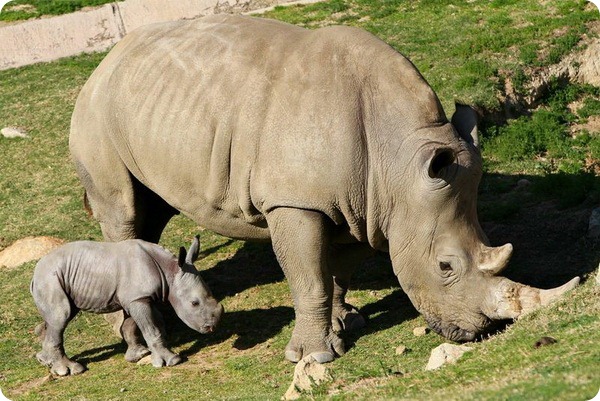
Interesting Facts
- The inhabitants of Europe saw the rhino for the first time only in 1513. The rhino was a gift to the Portuguese sailors by the Indian Raja Cambie. At first, a strange beast was exhibited to the amusement of the crowd. Then the Portuguese decided to send it as a gift to the Pope.
- The World Wildlife Fund WWF has established a special “rhino day” which is celebrated on September 22.
- The large woolly rhinoceros of elasmotheries once lived in the forests of Europe. Unfortunately, it disappeared 8 thousand years ago.
- The word “rhino” itself is found in the name of many other animals, for example, there is a rhinoceros beetle, a viper rhinoceros, a hornbill, an iguana-rhino, a rhinoceros fish. They all have horns, which makes them look like our today’s hero – a rhinoceros.
References and Further Reading
- Owen-Smith, Norman (1984). Macdonald, D. (ed.). The Encyclopedia of Mammals. New York: Facts on File. pp. 490–495. ISBN 978-0-87196-871-5.
- Vietnam’s Appetite For Rhino Horn Drives Poaching In Africa, by Frank Langfitt, 13 May 2013.
- Gouws, Andries (8 October 2010). “Kan renosterstropers gestuit word?”. Landbouweekblad: 4–6.
- “What is a rhinoceros horn made of?”. Yesmag.bc.ca. 9 October 2003. Archived from the original on 28 September 2011. Retrieved 23 September 2010.
- Tougard, C. et al. (2001) Phylogenetic relationships of the five extant Rhinoceros species (Rhinocerotidae, Perissodactyla) based on mitochondrial cytochrome b and 12S rRNA genes.

Author: Pavlo Chaika, Editor-in-Chief of the journal Poznavayka
When writing this article, I tried to make it as interesting and useful as possible. I would be grateful for any feedback and constructive criticism in the form of comments to the article. You can also write your wish/question/suggestion to my mail pavelchaika1983@gmail.com or to Facebook.

